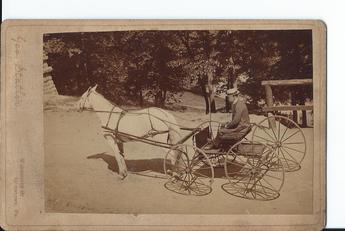The Hamilton Family and the 1889 Johnstown Flood
In 1889 my great grandparents Joseph and Eckie Hamilton were living in and managing a boarding house at 136 Jackson Street, Johnstown, Pennsylvania. On May 31 of that year the Johnstown Flood hit the city taking 2208 lives.
Two accounts of our family's survival through the flood have been passed down:
My father told us that his father James (Joseph's oldest son) worked in a livery stable in Johnstown and jumped on a horse and rode up the hills to home when the dam burst. We have a picture said to be of the horse that he rode.
My second cousin's account goes like this, quoting a letter from her father:
"Now let me explain where our family lived in 1887. They owned, or operated the opera house near the east end of Washington street, which ran parallel to the little conemaugh river. The flood wave came down the conemaugh valley and hit the east end of Washington and devastated the city in 10 minutes. I think they had living quarters and a barn behind the theater."
She also states:
"We have an interesting story passed down to us from Grandpa Tom, about their escape from the Johnstown flood that you may have not heard. They fled with the help of the big white family horse. Tom, age 4, was seated on the horse, when either Joseph or older brother Jim, (we are not sure) led the horse to the hillside through 3 feet of water with Had (Henry) hanging onto the horse's tail."
Related facts
Joseph Hamilton was listed as a teamster in the 1887 City Directory of Johnstown while living at 136 Jackson Street. They were at the same address in May 1889. If he was still a teamster then he had access to horses. Perhaps he kept his horses in the barn behind the Opera House. His son James, age 17, would likely have known how to handle horses.
The horse in our picture is a big, white one. On the other hand, it is attached to a small carriage ridden by a man who is not a Hamilton. The photo is a stock photo taken by George Statler, Washington St, Johnstown.

Why were they were able to leave in time?
The Johnstown City Directory of 1889 says that the rivers and creeks had overflowed their banks from the heavy rain and there was 1 to 3 feet of water in the streets in the 3rd Ward during the day of May 31. It then says:
"The first intimation the doomed citizens had of the approaching demon of destruction was the ringing of bells and blowing of whistles. This was done by those in East Conemaugh and Woodvale, when they saw the danger, to warn those in its path below."
David McCullough's book, The Johnstown Flood, page 145, adds
"it was later reported that a freight engineer named Hugh Clifford had raced his train from above the depot across the stone bridge, his whistle going the whole way, and a man named Charles Horner blew the whistle over at Harry Swank's machine shop."
What happened to some other people?
Joseph's sister and brother in law, Emma and Thomas McClelland, were at 42 Market Street, Johnstown. They and their son James, born in February 1889, survived and remained in Johnstown.
Joseph's sister Annie Hamilton had not yet married. I don't know if she was in Johnstown on the day of the flood, but if so she survived. She married David Lavely in Johnstown in 1898 and died in 1916.
Joseph's sister Maria had married David Edwards about 1868 and was living in Altoona at the time of the flood.
There were three men living at the boarding house in 1889. One of them, Ed Bartholomew, is listed as "unaccounted for" in the City Directory. Josiah Kauffman evidently survived, married Juniata Kniepper, and was living in Johnstown in 1900. The third, Isaiah J Bosler, may be the man of the same name living in Elyria, Ohio, in 1910. That man had been born in PA about 1865 and had married a woman from Pennsylvania in 1895.
What happened to the Union Hall or "opera house?"
The section of the 1889 City Directory that was written before the flood says this on page 153:
"Johnstown has but one theater building. It is situated at the corner of Franklin and Washington streets, and Messrs. Weaver & Jordan are managers. It is a frame structure, but two stories in height, and does not impress one as being either large or beautiful, but inside it is fitted up very nicely."
A wood frame building on Washington Street didn't stand much of a chance, so it is no surprise that Annie (Hamilton) Lavely's obituary states:
"Mrs. Lavely's father was in charge of the old Union Hall, corner of Washington and Franklin streets, Second Ward, which was washed away in the Johnstown Flood."